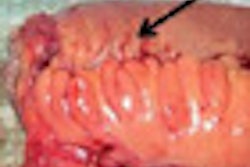Reducing tube current may be a popular way to lower CT radiation dose, but it's not necessarily an effective one. In a new study, medical physicists from Greece found that organ dose reductions resulting from tube current modulation with automated exposure control (AEC) can vary -- especially in children.
At a minimum, AEC systems should be deactivated before scanning pediatric patients, the group reported at the 2010 European Congress of Radiology (ECR).
"Several studies have reported on the results of these AEC systems, but the dose reductions are based on the average reduction of tube current," said lead investigator Antonios Papadakis from the University of Crete in Heraklion.
"Dose reduction calculations are based on the average reductions in the modulated mAs, and may not represent dose reduction to specific organs," Papadakis said. Tube current reduction and actual radiation dose reduction are two different things.
In its 2007 recommendations, the International Commission on Radiological Protection (ICRP) cited the potential variance, noting that "reductions in tube current [mAs] may not represent a dose reduction in specific organs," Papadakis said. "And, therefore, the average effective dose may not scale linearly with the tube current."
The researchers wanted to compare tube current and organ dose by scanning a series of phantoms loaded with thermoluminescent dosimeters (TLDs) and measuring the dose results.
The study sought to "investigate the effect of AEC on organ dose and effective dose, and investigate the relationship between the reduction in tube current and reductions in organ and effective dose," Papadakis said.
The researchers used five anthropomorphic phantoms simulating average-sized individuals for a neonate, a 1-year-old, a 5-year-old, a 10-year-old, and an adult.
The phantoms were scanned using a 16-detector-row CT scanner equipped with an x-, y-, and z-axis modulation-based AEC (CARE Dose 4D, Siemens Healthcare, Erlangen, Germany).
Each phantom was first scanned with a fixed tube current, and then scanned again with the AEC activated, Papadakis explained.
During scanning, the dosimeters (TLD-100 and TLD-200) measured the absorbed dose for all radiosensitive organs. The researchers measured organ dose and effective dose for head, thoracic, and abdominal and pelvic standard scans in each phantom, based on ICRP 103 recommendations (Annals of the ICRP, 2007, Vol. 37:2-4, pp. 1-332).
Organ dose and effective dose reduction were then compared to the corresponding mAs reduction.
The results showed a large amount of variability in the organ doses resulting from tube current reductions, with some doses (denoted by minus signs, below) actually increasing with the use of AEC, Papadakis said.
Effective dose changes with AEC
|
||||||||||||||||||||||||
| Dose changes preceded by minus signs indicate dose increases. |
The absolute difference between effective dose and organ dose reduction was up to 40%, Papadakis said, while the percentage effective dose reduction agreed well with the percentage mAs reduction (p < 0.001).
mAs vs. effective dose reductions for head and neck CT scans
|
mAs vs. effective dose reductions for abdominal and pelvic CT scans
|
||||||||||||||||||||||||
| Dose changes preceded by minus signs indicate dose increases. |
"Dose reductions achieved using AEC vary considerably among different radiosensitive organs," Papadakis concluded. "AEC is generally less efficient in children compared to adults. Tube current reduction ... is an inaccurate estimate of effective dose reduction."
In response to a question from the audience, Papadakis said he hasn't tested other AEC systems, which would be needed to draw firm conclusions about any manufacturer's particular system. In addition, the estimated error in the dose measurements could be as high as 10%, he cautioned.
Broadly speaking, AEC is an efficient tool for reducing patient radiation burden in CT scans, Papadakis said, but it is considerably less efficient in children than in adults. As a result, AEC should be deactivated when scanning the neonate thorax and when performing abdominal and pelvic scans in 10-year-olds to avoid potential increases in dose.
By Eric Barnes
AuntMinnie.com staff writer
April 15, 2010
Related Reading
Organ-based tube-current modulation cuts breast dose, March 8, 2010
CT doses, widely variable in Europe, are reduced by staff efforts, March 6, 2010
320-row CT minimizes dose in pediatric abdominal studies, March 3, 2010
NIH tells scanner suppliers to include radiation monitoring, February 1, 2010
Controversy can't alter facts: Screening mammography has proven benefits, December 2, 2009
Copyright © 2010 AuntMinnie.com



















